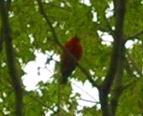Yesterday I stepped outside to see a flock of seven to ten birds (maybe more) flitting about in the lilac and Manitoba maple just off the corner of the house. Yellowish, dark wings, pale beaks, not too small. Orioles? They'd have to be Orchard Orioles, which would be interesting, since we are just beyond the normal range of the Orchard, though they're moving into our area. But not only are the beaks pale, but they're a bit too heavy for an oriole.
I took a few pictures, which didn't show much (got to get a better camera ...). I got the best looks I could, but they were moving fast in and out of the foliage. Gleaning? A little flycatching? I came in and consulted the books (mainly Sibley's). My guesses didn't seem to be quite right. I decided to sleep on it.
This morning I went back to the sometimes-successful method of flipping through the book. Identification is so much easier when you already know generally what kind of bird you are looking at: finch, oriole, vireo, even warbler, narrows the question down nicely. It doesn't always lead to an answer, think flycatcher, sparrow, for example, but it gives you a basis for inquiry. Without that, you're left with the flip method. It sometimes fails--gives one an odd feeling when it does: when one looks at every bird in the guide and doesn't see the bird that just passed through the yard. But it happens a lot.
In spring birds arrive in their breeding plumage, and are often singing territorial songs long before they get to their breeding grounds. It's always tough to identify birds out of context, but the plumage and songs make it much easier. In the fall, most birds are in winter plumage and singing is sporadic and often off key (though I did hear a pretty vireo song this morning).
So, there I was flipping. Considering perusing the finches (though it wasn't any finch I knew), when I stumbled into the tanagers. And there it was: Scarlet Tanager (Piranga olivacea).
 The male in breeding plumage is unmistakable in his brilliant scarletness. But this is a bird I've only seen a few times (for example, May 2006, Prince Edward County--at right).
The male in breeding plumage is unmistakable in his brilliant scarletness. But this is a bird I've only seen a few times (for example, May 2006, Prince Edward County--at right).The Scarlet Tanager lives in mature deciduous forest, a kind of habitat I visit sometimes, but not one I enjoy every day. In other words, this is not a bird I know the giss of, and certainly not a bird I expect to find feeding in the yard.
A little later on I was back out in the yard. The tanagers were gone, and among the chickadees now feeding in the same Manitoba maple there was a Yellow-rumped Warbler. Now that's a fall migrant I expect to see!






3 comments:
Great detective work. It's almost a shame to see a brilliant dimorphic bird like the scarlet tanager in its drap plumage.
Tanagers giss a lot like orioles, to me. I hear their picky-tuck call about a million more times than I hear their song or see them.
Nice spot!
Thanks, Mike. It's a surprise all right to see how plain a tanager can be--but it does let you see what the bird is really like, in a way, undistracted by the showy colour.
Rurality, its good to hear that this bird is somewhat oriole-like to someone else! I wish I knew their call--must spend more time in some real woods next year.
Post a Comment